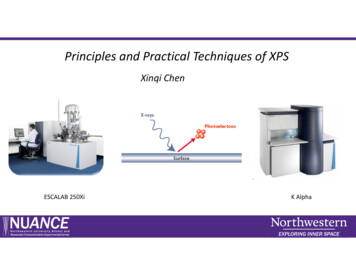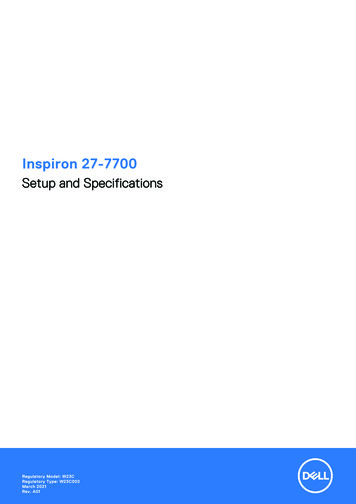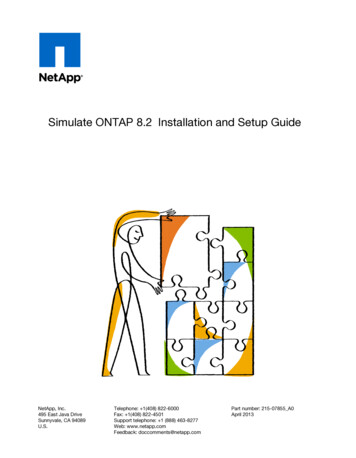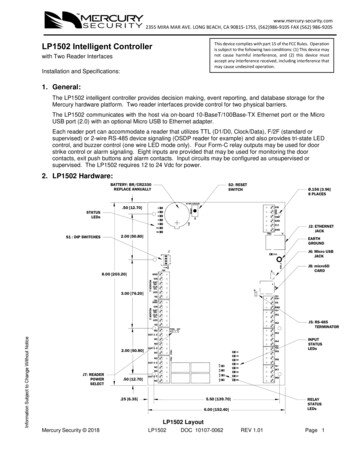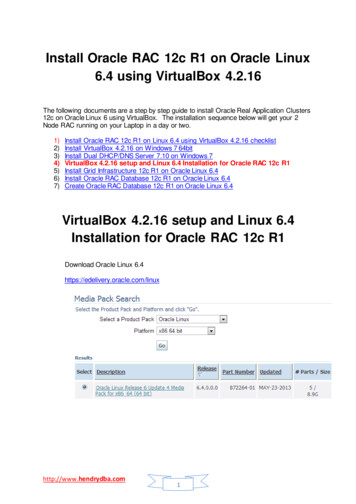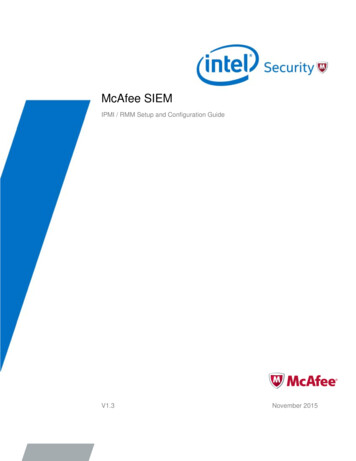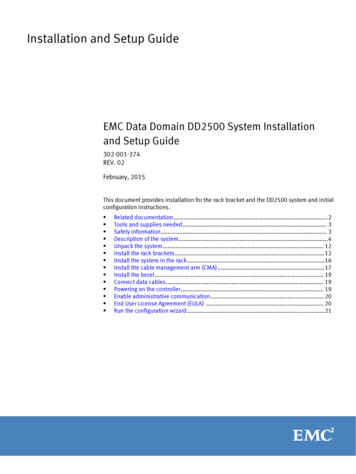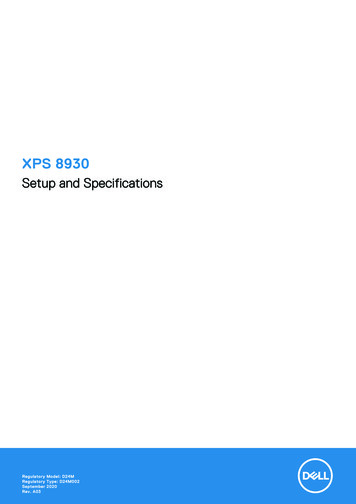
Transcription
XPS 8930Setup and SpecificationsRegulatory Model: D24MRegulatory Type: D24M002September 2020Rev. A03
Notes, cautions, and warningsNOTE: A NOTE indicates important information that helps you make better use of your product.CAUTION: A CAUTION indicates either potential damage to hardware or loss of data and tells you how to avoidthe problem.WARNING: A WARNING indicates a potential for property damage, personal injury, or death. 2017-2020 Dell Inc. or its subsidiaries. All rights reserved. Dell, EMC, and other trademarks are trademarks of Dell Inc. or its subsidiaries.Other trademarks may be trademarks of their respective owners.
ContentsChapter 1: Set up your computer. 4Chapter 2: Create a USB recovery drive for Windows. 7Reinstall Windows using a USB recovery drive. 7Chapter 3: Setting up the Virtual Reality (VR) headset — optional.8Chapter 4: Views. 9Front. 9Back.10Back panel. 11Chapter 5: Specifications. 13Computer model. 13System information.13Operating system. 13Dimensions and weight. 13Memory.14Intel Optane memory.14Ports and connectors.15Communications.15Wireless module.16Audio. 16Storage. 16Video. 16Power ratings. 17Computer Environment.17Chapter 6: Intel Optane memory. 18Enabling Intel Optane memory.18Disabling Intel Optane memory. 18Chapter 7: Getting help and contacting Dell.19Contents3
1Set up your computer1. Connect the keyboard and mouse.2. Connect to your network using a cable, or connect to a wireless network.3. Connect the display.NOTE: If you ordered your computer with a discrete graphics card, the HDMI and the display ports on the back panel ofyour computer are covered. Connect the display to the discrete graphics card.4. Connect the power cable.4Set up your computer
5. Press the power button.6. Finish Windows setup.Follow the on-screen instructions to complete the setup. When setting up, Dell recommends that you: Connect to a network for Windows updates.NOTE: If connecting to a secured wireless network, enter the password for the wireless network access whenprompted. If connected to the internet, sign-in with or create a Microsoft account. If not connected to the internet, create anoffline account. On the Support and Protection screen, enter your contact details.7. Locate and use Dell apps from the Windows Start menu—RecommendedTable 1. Locate Dell appsResourcesDescriptionMy DellCentralized location for key Dell applications, help articles, and other important information aboutyour computer. It also notifies you about the warranty status, recommended accessories, andsoftware updates if available.SupportAssistPro-actively checks the health of your computer’s hardware and software. The SupportAssist OSRecovery tool troubleshoots issues with the operating system. For more information, see theSupportAssist documentation at www.dell.com/support.NOTE: In SupportAssist, click the warranty expiry date to renew or upgrade your warranty.Dell UpdateSet up your computer5
Table 1. Locate Dell apps (continued)ResourcesDescriptionUpdates your computer with critical fixes and latest device drivers as they become available. Formore information about using Dell Update, see the knowledge base article SLN305843 atwww.dell.com/support.Dell Digital DeliveryDownload software applications, which are purchased but not pre-installed on your computer. Formore information about using Dell Digital Delivery, see the knowledge base article 153764 atwww.dell.com/support.8. Create recovery drive for Windows.NOTE: It is recommended to create a recovery drive to troubleshoot and fix problems that may occur with Windows.For more information, see Create a USB recovery drive for Windows.6Set up your computer
2Create a USB recovery drive for WindowsCreate a recovery drive to troubleshoot and fix problems that may occur with Windows. An empty USB flash drive with aminimum capacity of 16 GB is required to create the recovery drive.NOTE: This process may take up to an hour to complete.NOTE: The following steps may vary depending on the version of Windows installed. Refer to the Microsoft support site forlatest instructions.1. Connect the USB flash drive to your computer.2. In Windows search, type Recovery.3. In the search results, click Create a recovery drive.The User Account Control window is displayed.4. Click Yes to continue.The Recovery Drive window is displayed.5. Select Back up system files to the recovery drive and click Next.6. Select the USB flash drive and click Next.A message appears, indicating that all data in the USB flash drive will be deleted.7. Click Create.8. Click Finish.For more information about reinstalling Windows using the USB recovery drive, see the Troubleshooting section of yourproduct's Service Manual at www.dell.com/support/manuals.Topics: Reinstall Windows using a USB recovery driveReinstall Windows using a USB recovery driveCAUTION: This process formats the hard drive and removes all data on your computer. Ensure that you back updata on your computer before beginning this task.NOTE: Before reinstalling Windows, ensure your computer has more than 2 GB of memory and more than 32 GB of storagespace.NOTE: This process may take up to an hour to complete and your computer will restart during the recovery process.1. Connect the USB recovery drive to your computer.2. Restart your computer.3. Press F12 after the Dell logo is displayed on the screen to access the boot menu.A Preparing one-time boot menu message appears.4. After the boot menu loads, select the USB recovery device under UEFI BOOT.The system reboots and a screen to Choose the keyboard layout is displayed.5. Choose your keyboard layout.6. In the Choose an option screen, click Troubleshoot.7. Click Recover from a drive.8. Choose one of the following options: Just remove my files to do a quick format. Fully clean the drive to do a complete format.9. Click Recover to start the recovery process.Create a USB recovery drive for Windows7
3Setting up the Virtual Reality (VR) headset— optional1. Download and run the setup tools for your VR headset at www.dell.com/VRsupport.2. Connect the VR headset to the designated USB 3.1 Gen 1 ports on the back of your computer and HDMI port on thegraphics card on your computer, when prompted.NOTE: If you connect the VR headset to the HDMI port on your computer, the performance will be optimum.3. Follow the instructions on the screen to complete the setup.8Setting up the Virtual Reality (VR) headset — optional
4ViewsTopics: FrontBackBack panelFront1. Power buttonPress to turn on the computer if it is turned off, in sleep state, or in hibernate state.Press to put the computer in sleep state if it is turned on.Press and hold for 4 seconds to force shut-down the computer.NOTE: You can customize the power-button behavior in Power Options. For more information, see Me and My Dell atwww.dell.com/support/manuals.2. SD-card slotReads from and writes to the SD card.3. Headphone/speaker portConnect headphones or speakers.4. Microphone portViews9
Connect an external microphone to provide sound input.5. USB 3.1 Gen 1 (Type-C) portConnect to external storage devices. Provides data transfer speeds up to 5 Gbps.NOTE: This port does not support video/audio streaming.6. USB 3.1 Gen 1 ports (3)Connect peripheral such as storage devices and printers. provides data transfer speeds up to 5 Gbps.7. Optical driveReads from and writes to CDs and DVDs.8. Optical-drive eject buttonPress to open the optical drive tray.Back1. Back panelConnect USB, audio, video, and other devices.2. PCI-Express X16 graphics slotConnect a PCI-Express card such as graphics, audio, or network card to enhance the capabilities of your computer.NOTE: The port on the graphics card may vary depending on the graphics card ordered.3. PCI-Express X1 slots (2)Connect a PCI-Express card such as graphics, audio, or network card to enhance the capabilities of your computer.4. PCI-Express X4 slotConnect a PCI-Express card such as graphics, audio, or network card to enhance the capabilities of your computer.5. Service Tag label10Views
The Service Tag is a unique alphanumeric identifier that enables Dell service technicians to identify the hardwarecomponents in your computer and access warranty information.6. Bottom power-supply cage release-latchRelease to rotate the power supply, once the side panel is released.7. Top power-supply cage release-latchRelease to rotate the power supply, once the side panel is released.8. Power-supply diagnostics buttonPress to check the power‑supply state.9. Power-supply lightIndicates the power-supply light.Press and hold the power-supply diagnostics button. The power-supply light changes to green if the power-supply unit isworking fine.10. Power portConnect a power cable to provide power to your computer.11. Security-cable slot (for Kensington locks)Connect a security cable to prevent unauthorized movement of your computer.12. Side panel release latchPull to release and open the side panel.Back panel1. Network port - 10/100/1000 Mbps (with lights)Connect an Ethernet (RJ45) cable from a router or a broadband modem for network or Internet access.The two lights next to the connector indicate the connectivity status and network activity.2. USB 2.0 ports (2)Views11
Connect peripherals such as external storage devices and printers. Provides data transfer speeds up to 480 Mbps.3. DisplayPortConnect an external display or a projector.NOTE: If you ordered your computer with a discrete graphics card, the DisplayPort on the back panel of your computeris covered. Connect the display to the discrete graphics card of your computer.4. HDMI portConnect a TV or another HDMI-in enabled device. Provides video and audio output.NOTE: If you ordered your computer with a discrete graphics card, the HDMI port on the back panel of your computeris covered. Connect the display to the discrete graphics card of your computer.5. USB 3.1 Gen 1 ports (3)Connect peripherals such as storage devices and printers. Provides data transfer speeds up to 5 Gbps.6. USB 3.1 Gen 2 Type-C portConnect peripherals such as external storage devices and printers. Provides data transfer speeds up to 10 Gbps.7. USB 3.1 Gen 2 portConnect per
Locate and use Dell apps from the Windows Start menu—Recommended Table 1. Locate Dell apps Resources Description My Dell Centralized location for key Dell applications, help articles, and other important information about your computer. It also notifies you about the warranty status, recommended accessories, and software updates if available. SupportAssist Pro-actively checks the health of .
